DIT University Dehradun, India
Corresponding author Email: sandy06.gcect@gmail.com
Article Publishing History
Received: 22/12/2019
Accepted After Revision: 27/02/2019
A wireless sensor network consists of a huge number of sensor nodes associated via wireless medium. Nodes in a WMSN(Wireless Medical Sensor Network) are organized with limited battery energy and thus improvement on network lifetime by reducing energy-usage is of extreme important. One of the solutions to minimize such energy-usage is associate clustering of network nodes. In this paper an associate clustering scheme in WMSN is proposed where cluster heads are formed by creating a probable associate list is in descending order in which cluster heads are organized according to their residual energy. We have conducted simulation-based evaluations to compare the performance of EEACPSC against Energy Aware Coverage Preservation and Lifetime Enhancement Protocol (EACPLEP) and Enhanced-Energy Efficient Protocol with Static Clustering (E3PSC). Our experiment results show that the performance of present scheme is much better than the previous one. And it provides better result. 40.3% gain of EEACPSC over E3PSC and 25.3% gain over EACPLEP in terms of number of nodes alive in the network.
Cluster Head, Network Lifetime, Energy Efficiency, Wireless Medical Sensor Network
Mandal S, Sushil R. A low Energy Based Event Driven and Secure Node Deployment Protocol for Wireless Medical Sensor Network. Biosc.Biotech.Res.Comm. 2019;12 (1).
Mandal S, Sushil R. A low Energy Based Event Driven and Secure Node Deployment Protocol for Wireless Medical Sensor Network. Biosc.Biotech.Res.Comm. 2019;12(1). Available from: https://bit.ly/2WKUCXa
Copyright © Mandal and Sushil, This is an open access article distributed under the terms of the Creative Commons Attribution License (CC-BY) https://creativecommns.org/licenses/by/4.0/, which permits unrestricted use distribution and reproduction in any medium, provide the original author and source are credited.
Introduction
Innovations in industrial, home and automation in transportation represent smart environments. Data for smart environments are obtained through Wireless Medical Sensor Networks (WMSN), where thousands of sensors are deployed at different locations operating in different modes, (Cook et al, 2004). A sensor network is capable of sensing, processing and communicating which helps the base station or command node to observe and react according to the condition in a particular environment (physical, battle field, biological) (Sohraby et al, 2007). Sensor network protocols have a unique self-organizing capability. Another interesting feature of WMSNs is that the sensor nodes cooperate with each other. Sensor nodes have an in-built processor, using which raw data are processed before transmission. These features facilitate wide range of applications of WMSNs ranging from biomedical, environmental, military, event detection and vehicular telematics, (Akyildizet al, 2002). In this paper we assume a sensor network model, similar to those used in (Mandal et al, 2018), with the following properties:
- All sensor nodes are immobile and homogeneous with a limited stored energy.
- The nodes are equipped with power control capabilities to vary their transmitted power.
- None of the nodes know their location in the network.
- Each node senses the environment at a fixed rate and always has data to send to the base station.
- Base station is fixed and not located between sensor nodes.
In this paper, we propose EEACPSC (An Enhanced Energy Aware Coverage Preservation with Static Clustering), a hierarchical static clustering based protocol, which eliminates the overhead of dynamic clustering and as a result prolongs the network lifetime. In this scheme, cluster heads are selected by creating a probable associate list where cluster heads are organized according to their residual energy and all the rounds are divided into iteration. The rest of paper is organized as follows. Section 2 describes the proposed scheme followed by the supporting algorithm. Performance-evaluation (Mandal et al, 2019) and simulation results are presented in section 3. The entire work is concluded in section 4 and 5.
Proposed Scheme
This section contains the proposed scheme, An Enhanced Energy Aware Coverage Preservation with Static Clustering (EEACPSC) followed by the algorithm of the proposed scheme. The present scheme is a modifi cation of an existing scheme, An Enhanced Energy-Efficient protocol with Static Clustering (E3PSC) [Loscri V et al, 2005] and Energy Aware Coverage Preservation and Lifetime Enhancement Protocol (EACPLEP) [Junepei et al, 2004] In the present work, cluster heads are choose by creating a probable associate list for next n number of rounds and the entire cluster heads are organized according to their residual energy.
Algorithm (EEACPSC)
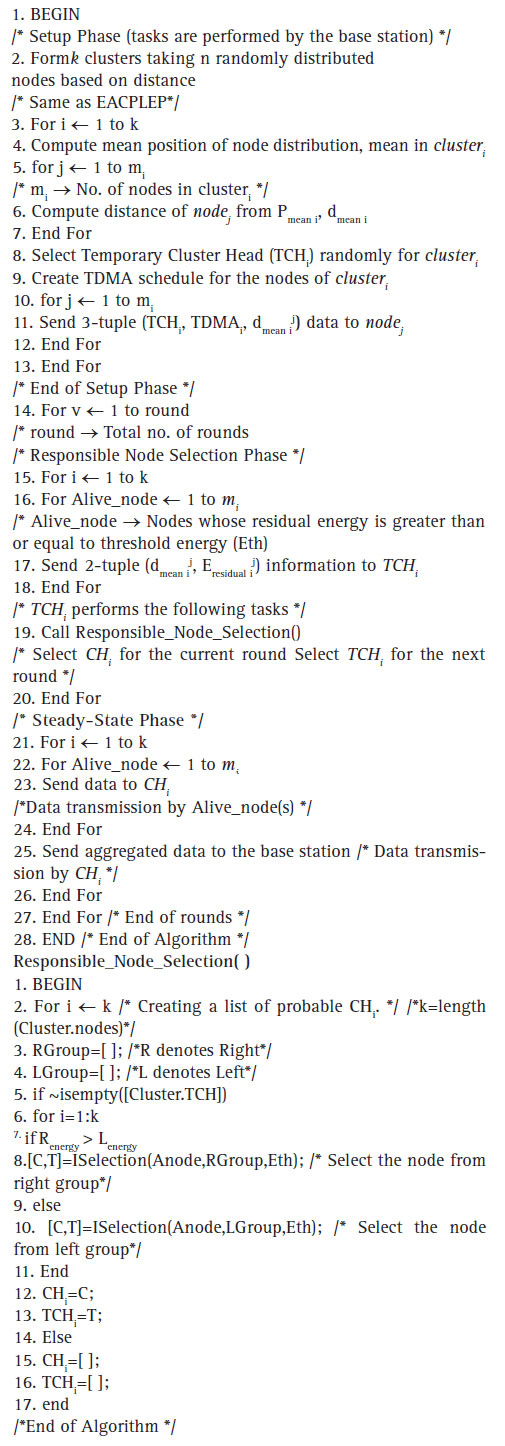
Performance Comparison
Qualitative Analysis
The network lifetime is defined in terms of energy-usage. The associate list is determined in such a manner that presence of cluster head within a list is sufficient and further, to keep the network alive, probable list needs to be associated. To declare the network alive, we can say that for every round the cluster head with maximum energy among all the pre-decided cluster heads within that list should be greater than a threshold energy level Ethreshold beyond which the node is considered as a dead. Since this must hold for every round, we can easily considered that only the minimum of these energies should be above Ethreshold thereby guarantees that each round has sufficient energy to keep the network alive.
Quantitative Analysis
Simulation Environment
To evaluate the performance of EEACPSC, MATLAB 7.1 is used as a simulation tool. We consider that the sensor nodes are deployed randomly across in plain area of (xm = 100m X ym = 100m) and the base station is located (x=50, y=175). Each node is equipped with equal amount of initial energy (2J) at the beginning of the simulation. Further we assume that WMSN is working in continuous data fl ow application domain. Table 1 represents various parameters and their values used in simulation.
Simulation Metric
The performance of the scheme is evaluated considering network lifetime as a parameter which is defined as the time until the last node dies in the network. Network lifetime is measured using following yard-stick.
- Number of nodes alive in the network : more number of nodes alive involves network lifetime last longer.
- 3D result: results are in 3D format which outperforms better performance as compare to E3PSC and EACPLEP.
Results and Discussion
A set of experiments is conducted to compare the performance of present scheme EEACPSC with E3PSC (Zahmati et al, 2007) and EACPLEP (Lindsay et al, 2002). Fig.1 shows that, after 26 seconds, only 67 nodes are alive over the network. Fig. 2 shows that, after 26 seconds, only 75 nodes are alive over the network.
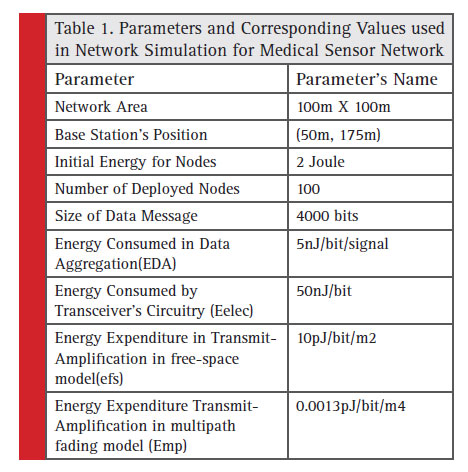 |
Table 1: Parameters and Corresponding Values used in Network Simulation for Medical Sensor Network |
 |
Figure 1: Comparison of EEACPSC with E3PSC in terms of number of nodes alive in the network over time |
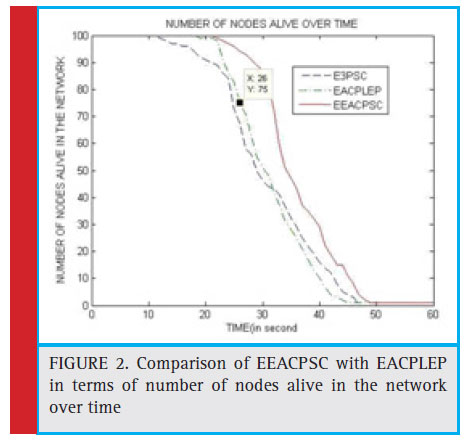 |
Figure 2: Comparison of EEACPSC with EACPLEP in terms of number of nodes alive in the network over time |
 |
Figure 3: Number of nodes alive in the network over time in EEACPSC |
Fig. 3 shows that, after 26 seconds, 94 nodes are alive over the network. After comparing these 3 graphs we conclude that the performance of present scheme is much better than the previous one. And it provides better result. 40.3% gain of EEACPSC over E3PSC and 25.3% gain over EACPLEP
in terms of number of nodes alive in the network. Following are the representation of 3D graphs. In fig 4, there is a deployment of 150 nodes instantly and after 460 seconds there are 145 nodes alive in the network. Fig.5 indicates that, after 460 seconds, there are 150 nodes alive over the network. Fig.6 shows that, after 460 seconds, 155 nodes are alive over the network. After comparing these 3D graphs, we conclude that the performance of present scheme is better as compare to previous scheme. 6.89% gain of EEACPSC over E3PSC and 3.33% gain over EACPLEP in terms of number of
nodes alive in the network.
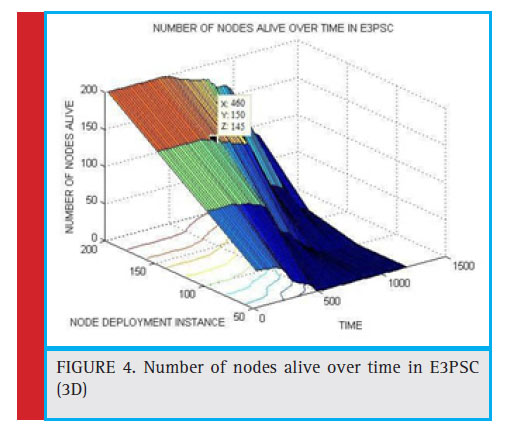 |
Figure 4: Number of nodes alive over time in E3PSC (3D) |
 |
Figure 5: Number of nodes alive over time in EACPLEP (3D) |
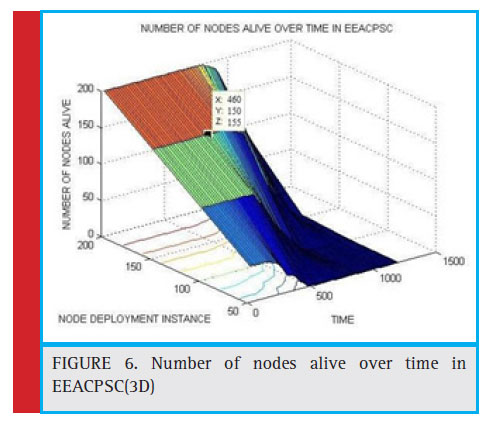 |
Figure 6: Number of nodes alive over time in EEACPSC(3D) |
In this paper an energy-efficient routing scheme EEACPSC for WMSN is proposed. The EEACPSC is developed by modifying an existing routing scheme E3PSC and EACPLEP with an objective to prolong network lifetime further (more number of nodes alive in the network). With the results of simulation, we can conclude that in the case of EACPLEP, the intra-cluster communication is increased, which is removed in the EEACPSC, because the cluster head will be choose on the basis of creating a probable list of nodes.
So the energy dissipated in the node to cluster head is less than the EACPLEP. And it organizes by the 3D graph also. So we can say that EEACPSC is more energy efficient and coverage preserving as compare to E3PSC and EACPLEP and spatial allocation of nodes plays a vital role in the election of cluster-heads for network operation. As per the quantitative results, EEACPSC proves to be better performer than EACPLEP and E3PSC.
As future work, we intend to study more complicated situations, like coverage problems in case of mobile nodes, heterogeneous sensor networks consisting nodes of different capabilities, and other non-disk coverage models.
References
Akyildiz I.F., Su W, Sankarasubramaniam Y, and Cayirci E (2002), Wireless sensor networks: A survey
Amir SepasiZahmati and Bahman Abolhassani (2007), EPMPLCS: An Efficient Power Management Protocol with Limited Cluster Size for Wireless Sensor Networks Proc. 27th International Conference on Distributed Computing Systems (ICDCS 2007)Computer Networks, vol. 38, pp. 393-422
Cook D. J. and Das S. K. (2004), Smart environments: technologies, protocols and applications New York:John Wiley, pp. 13-15
Heinzelman W.R. Chandrakasan A.P, and Balakrishnan H. (2000), Energy- Effi cient Communication Protocol for Wireless Microsensor Networks, Proc. 33rd Hawaii Int’l. Conf. Sys. Sci.,Jan 2000.
JunpeiKamimura and Naoki Wakamiya and Masayuki Murata (2004)Energy-effi cient clustering method for data gathering in sensor networks,” in Proceedings of First Workshop ON Broadband Advanced Sensor Networks
Lindsey S, Raghavendra C and Sivalingam K. M (2002), Data- Gathering Algorithms in Sensor Networks using Energy Metrics, IEEE Trans. Parallel and Distrib. Sys., vol. 13, no. 9, Sept., pp. 924–35.
Loscri’ V. Marano S. ,Morabito G. (2005) A Two-Level Hierarchy for Low-Energy Adaptive Clustering Hierarchy (TLLEACH). Proceedings VTC2005 Dallas (USA), pp. 1809-1813.
Mandal, Sandip and Sushil, Rama (2018) Adaptive Modelling and Simulation of Wireless Sensor Radio Energy depends On Probabilistic and Stochastic Analysis, Institute of Integrative Omics and Applied Biotechnology Vol. 9 No. 2 pp. 129-135
Mandal, Sandip and Sushil, Rama (2018) Detection and Mitigation from Wormhole Based Protocol Deviation depends on Neighbor Discovery Approach In WSN, International Journal of Engineering and Technology Vol.7 No. 4 pp. 62-65
Mandal, Sandip and Sushil, Rama (2018) Energy Saving Dynamic Clustering Protocol for Wireless Sensor Network , International Journal of Engineering Applied and Management Sciences Paradigms Vol, 53 No. 03 pp. 25-28
Mandal, Sandip and Sushil, Rama (2018) Enhanced Energy- Balanced Lifetime Enhancing Clustering for WSN (EEBLEC), International Journal of Applied Engineering Research Vol 13 No. 16 pp. 12911—12916
Mandal, Sandip and Sushil, Rama (2018) Real time deployments of sensors and sensing patients vital parameters using secure autonomous WSN for medical applications, Bioscience Biotechnology Research Communications Vol. 11 No. 3 pp. 523-534
Mandal, Sandip and Sushil, Rama (2019) Security Enhancement Approach in WSN to Recovering from Various Wormhole- Based DDoS Attacks, Innovations in Soft Computing and Information Technology pp.179—190, Springer, Singapore Sohraby K., Minoli D., and Znati T. (2007)Wireless sensor networks: technology, protocols and applications,NewJersey: John Wiley, pp. 38-71
Yongcai Wang, Qianchuan Zhao and Dazhong Zheng (2004), Energy-Driven Adaptive Clustering Data Collection Protocol in Wireless Sensor Networks Proceedings of the 2004 International Conference on Intelligent Mechatronics and Automation, Chengdu, China.


